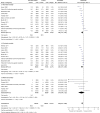Effective Linkages of Continuum of Care for Improving Neonatal, Perinatal, and Maternal Mortality: A Systematic Review and Meta-Analysis
- PMID: 26422685
- PMCID: PMC4589290
- DOI: 10.1371/journal.pone.0139288
Effective Linkages of Continuum of Care for Improving Neonatal, Perinatal, and Maternal Mortality: A Systematic Review and Meta-Analysis
Abstract
Background: Continuum of care has the potential to improve maternal, newborn, and child health (MNCH) by ensuring care for mothers and children. Continuum of care in MNCH is widely accepted as comprising sequential time (from pre-pregnancy to motherhood and childhood) and space dimensions (from community-family care to clinical care). However, it is unclear which linkages of care could have a greater effect on MNCH outcomes. The objective of the present study is to assess the effectiveness of different continuum of care linkages for reducing neonatal, perinatal, and maternal mortality in low- and middle-income countries.
Methods: We searched for randomized and quasi-randomized controlled trials that addressed two or more linkages of continuum of care and attempted to increase mothers' uptake of antenatal care, skilled birth attendance, and postnatal care. The outcome variables were neonatal, perinatal, and maternal mortality.
Results: Out of the 7,142 retrieved articles, we selected 19 as eligible for the final analysis. Of these studies, 13 used packages of intervention that linked antenatal care, skilled birth attendance, and postnatal care. One study each used packages that linked antenatal care and skilled birth attendance or skilled birth attendance and postnatal care. Four studies used an intervention package that linked antenatal care and postnatal care. Among the packages that linked antenatal care, skilled birth attendance, and postnatal care, a significant reduction was observed in combined neonatal, perinatal, and maternal mortality risks (RR 0.83; 95% CI 0.77 to 0.89, I2 79%). Furthermore, this linkage reduced combined neonatal, perinatal, and maternal mortality when integrating the continuum of care space dimension (RR 0.85; 95% CI 0.77 to 0.93, I2 81%).
Conclusions: Our review suggests that continuous uptake of antenatal care, skilled birth attendance, and postnatal care is necessary to improve MNCH outcomes in low- and middle-income countries. The review was conclusive for the reduction of neonatal and perinatal deaths. Although maternal deaths were not significantly reduced, composite measures of all mortality were. Thus, the evidence is sufficient to scale up this intervention package for the improvement of MNCH outcomes.
Conflict of interest statement
Figures







References
-
- WHO. World health statistics 2014. Geneva, Switzerland: 2014.
-
- WHO. The world health report 2013: research for universal health coverage. Geneva, Switzerland: 2013.
-
- Kerber KJ, de Graft-Johnson JE, Bhutta ZA, Okong P, Starrs A, Lawn JE. Continuum of care for maternal, newborn, and child health: from slogan to service delivery. Lancet. 2007;370(9595):1358–69. . - PubMed
Publication types
MeSH terms
LinkOut - more resources
Full Text Sources
Other Literature Sources
Medical

